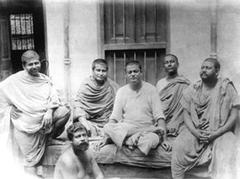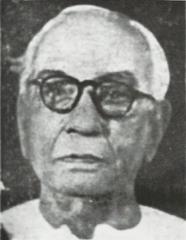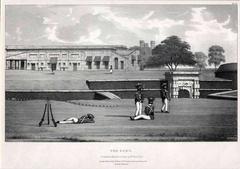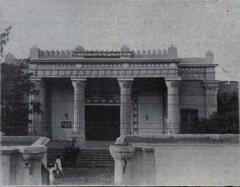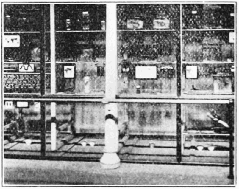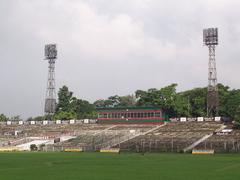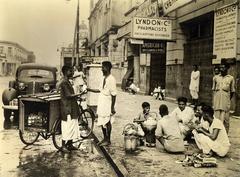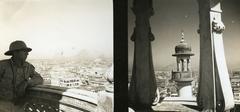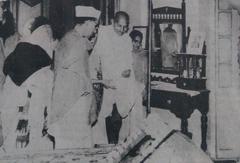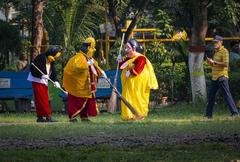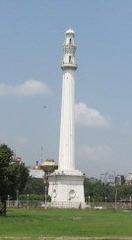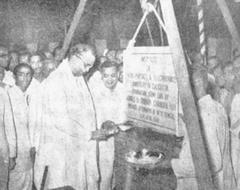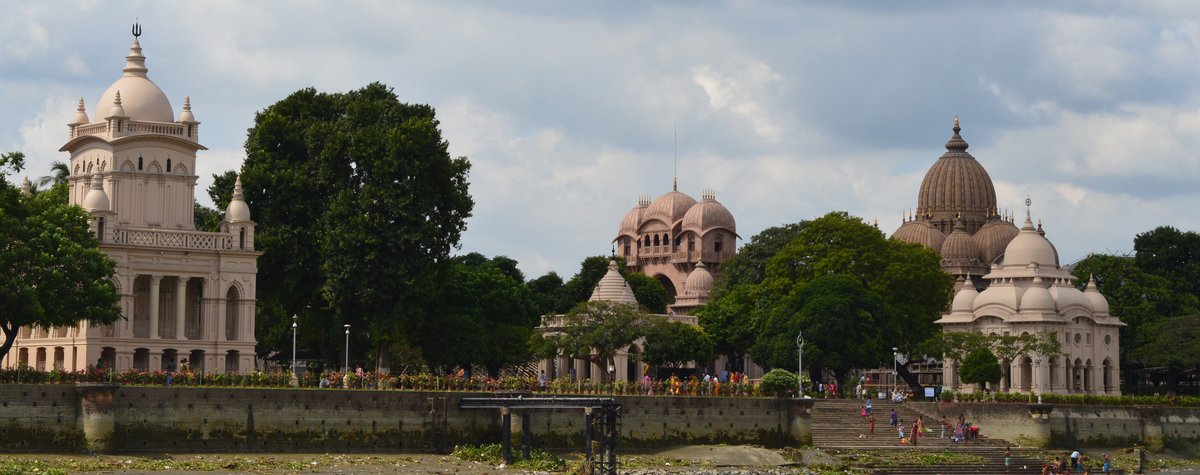
Guide to Sri Ramakrishna Temple: Visiting Information and Tips
Date: 16/07/2024
Introduction
The Sri Ramakrishna Temple, also known as Belur Math, stands as a monumental testament to spiritual unity and cultural heritage in Kolkata, India. Founded by Swami Vivekananda in 1898, the temple serves as the headquarters of the Ramakrishna Math and Mission, which is dedicated to the teachings of Sri Ramakrishna Paramahamsa. This revered site attracts millions of devotees and tourists annually, drawn by its architectural splendor, rich history, and profound spiritual significance. The temple’s unique design, blending elements from Hindu, Christian, Islamic, and Buddhist traditions, symbolizes the unity of all religions, a core teaching of Sri Ramakrishna (Belur Math Official Website). Visitors can explore its various shrines, meditation halls, and educational institutions, all contributing to its status as a beacon of spiritual enlightenment and social service. Whether you are a spiritual seeker, a history enthusiast, or a cultural explorer, the Sri Ramakrishna Temple offers a serene and enriching experience that resonates with the timeless values of universal brotherhood and selfless service (Cultural India).
Table of Contents
- Introduction
- History of Sri Ramakrishna Temple, Kolkata
- Visitor Information
- Special Features
- Cultural and Spiritual Impact
- Preservation and Conservation Efforts
- FAQ Section
- Conclusion
- Sources
History of Sri Ramakrishna Temple, Kolkata
Origins and Foundation
The temple was founded by Swami Vivekananda, a chief disciple of Sri Ramakrishna Paramahamsa, in 1898. The establishment of the temple was a fulfillment of Sri Ramakrishna’s vision of a universal temple that would serve as a center for spiritual enlightenment and social service. Swami Vivekananda’s efforts were instrumental in acquiring the land and overseeing the construction of the temple, which was completed in 1938 (Belur Math Official Website).
Architectural Significance
The architecture of the Sri Ramakrishna Temple is a unique blend of various religious styles, symbolizing the unity of all religions. The temple’s design incorporates elements from Hindu, Christian, Islamic, and Buddhist architectural traditions. The central dome resembles the Stupa of Sanchi, the arches are inspired by Islamic architecture, and the windows reflect the Gothic style of Christian churches. This eclectic architectural style was intended to convey the message of universal brotherhood and religious harmony, core teachings of Sri Ramakrishna (Cultural India).
Historical Milestones
Early 20th Century: The early 20th century was a period of significant growth and development for the Sri Ramakrishna Temple. In 1901, the first monastic disciples of Sri Ramakrishna, including Swami Brahmananda and Swami Shivananda, took residence at the Belur Math. This period also saw the establishment of various educational and charitable institutions under the aegis of the Ramakrishna Mission, which was founded by Swami Vivekananda in 1897. The mission’s activities included setting up schools, colleges, hospitals, and rural development centers, which played a crucial role in the socio-economic upliftment of the region (Ramakrishna Mission).
Mid 20th Century: The mid-20th century was marked by the expansion of the temple complex and the construction of additional buildings. In 1938, the main temple dedicated to Sri Ramakrishna was consecrated. This period also saw the establishment of the Vivekananda University in 1963, which aimed to provide higher education based on the principles of Vedanta and modern science. The university has since become a center of excellence in various fields, including humanities, social sciences, and natural sciences (Vivekananda University).
Late 20th Century to Present: The late 20th century and early 21st century have been periods of consolidation and further expansion for the Sri Ramakrishna Temple. The temple complex now includes several shrines, meditation halls, and residential quarters for monks and devotees. The Ramakrishna Mission continues to expand its activities, with a focus on education, healthcare, and rural development. The mission’s efforts have been recognized globally, and it has received several awards for its contributions to social service and spiritual upliftment (Ramakrishna Mission Awards).
Visitor Information
Visiting Hours
The Sri Ramakrishna Temple is open to visitors from 6:00 AM to 12:00 PM and from 3:30 PM to 8:30 PM. It’s advisable to check the official Belur Math Website for any changes in timings or special closures.
Ticket Prices
There is no entry fee to visit the temple. However, donations are welcome and help in the maintenance and development of the temple and its activities.
Travel Tips
- Best Time to Visit: The ideal time to visit is during the cooler months from October to March.
- How to Reach: The temple is well-connected by road and rail. It is about 5 kilometers from Howrah Railway Station and around 15 kilometers from Kolkata Airport.
Nearby Attractions
- Dakshineswar Kali Temple: Another significant religious site located close to Belur Math (Dakshineswar Kali Temple).
- Howrah Bridge: An iconic landmark in Kolkata, just a short drive away (Howrah Bridge).
- Indian Museum: A treasure trove of historical artifacts, located in the heart of Kolkata (Indian Museum).
Accessibility
The temple is wheelchair accessible, with ramps and designated pathways for differently-abled visitors.
Special Features
Special Events
The temple hosts numerous spiritual and cultural events throughout the year, including the birth anniversaries of Sri Ramakrishna, Swami Vivekananda, and Holy Mother Sarada Devi. These events attract thousands of devotees from around the world.
Guided Tours
Guided tours are available for visitors who wish to learn more about the temple’s history, architecture, and spiritual significance. These tours can be booked through the official website.
Photographic Spots
The serene Ganges riverfront, the majestic main temple, and the lush gardens offer excellent photographic opportunities for visitors.
Cultural and Spiritual Impact
The Sri Ramakrishna Temple has had a profound impact on the cultural and spiritual landscape of India and the world. The temple serves as a pilgrimage site for millions of devotees who come to seek spiritual solace and inspiration. The teachings of Sri Ramakrishna and Swami Vivekananda, which emphasize the unity of all religions and the importance of selfless service, continue to resonate with people from all walks of life. The temple also hosts various cultural and spiritual events, including lectures, seminars, and festivals, which attract participants from around the world (Belur Math Events).
Preservation and Conservation Efforts
The preservation and conservation of the Sri Ramakrishna Temple and its associated structures have been a priority for the Ramakrishna Mission. Efforts have been made to maintain the architectural integrity of the temple while ensuring that it meets modern safety and accessibility standards. The mission has also undertaken various initiatives to promote environmental sustainability, including the installation of solar panels and rainwater harvesting systems within the temple complex (Sustainability Initiatives).
FAQ Section
Q1: What are the visiting hours for Sri Ramakrishna Temple?
A1: The temple is open from 6:00 AM to 12:00 PM and from 3:30 PM to 8:30 PM.
Q2: Is there an entry fee for the temple?
A2: No, there is no entry fee, but donations are welcome.
Q3: What is the best time to visit Sri Ramakrishna Temple?
A3: The best time to visit is from October to March.
Q4: Are guided tours available?
A4: Yes, guided tours are available and can be booked through the official website.
Q5: Is the temple accessible for differently-abled visitors?
A5: Yes, the temple is wheelchair accessible.
Conclusion
The Sri Ramakrishna Temple stands as a testament to the enduring legacy of Sri Ramakrishna and Swami Vivekananda. Its rich history, architectural splendor, and cultural significance make it a must-visit destination for anyone seeking to understand the spiritual and cultural heritage of India. The temple’s message of universal brotherhood and selfless service continues to inspire and guide people around the world, making it a beacon of hope and enlightenment in today’s turbulent times. Plan your visit today and experience the spiritual serenity and cultural richness of this iconic landmark.

